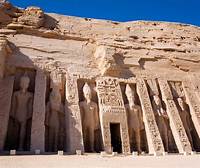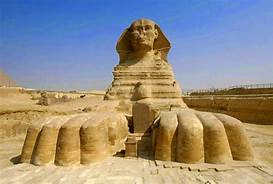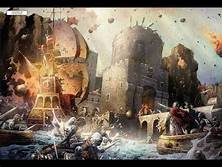National identity of Egypt
Creation of the first dynasty

The creation of the first dynasty under Menes around 3000 BC was the beginning of an empire. During this period, hieroglyphics began to appear as society begins to become organized in Egypt. It set the tone for the future of Egypt and set the foundation for how Egypt is today.
The Nile River

The Nile River was fundamental to Egypt’s success as a civilization. As it served as one of Egypt’s only large sources of water, it is not surprising that mostly every city was built near it. When the Nile would flood, it would fertilize the land thus allowing for the cultivation of crops in the region. The Nile also boosted Egypt’s economy through trade routes and protection from barbarians. It was not solely important to Egypt for its economic use, however. The Nile was sacred to their faith in Ancient Egypt. Egypt wouldn’t have been able to prosper and progress without the Nile River.
The Lighthouse of Alexandria

The Lighthouse at Alexandria is a fundamental structure and piece of architecture to Egyptian history. Although it was damaged on multiple occasions and is completely destroyed now, it served as a representation of Egypt’s power and strength. In fact, this structure serves as the quintessential lighthouse for architects today. It was built in the 3rd century BCE and completed by Ptolemy II. Although the large Egyptian fort of Quaitbey has been built over the landmark, it is important not to forget the importance and beauty of the lighthouse that once stood there.
The Pyramids of Giza

The Pyramids of Giza is the resting place of King Khufu who ruled from 2589 BCE until 2566 BCE, during the fourth dynasty of Egypt. This landmark stands 455 feet tall and is the oldest of the seven wonders of the world. Pyramids were an essential part of Egyptian culture, as they were not always actual tombs, but were monuments dedicated to the life of a ruler.
Ancient Egyptian Temples

It seems that the ancient Egyptian temples go unnoticed due to the popularity of the pyramids, but in my opinion, they are of equal importance. Many Ancient Egyptian temples continue to stand today in ruins because they were built in stone. These have been some of the most important factors in the acquisition of knowledge about Ancient Egypt because of their elaborate design as well as their specific dedication, often only to one deity of a specific region.
The Sphinx of Giza

The Sphinx of Giza is another well-known statue that came out of Ancient Egypt. It depicts a reclining sphinx, a mythological creature with a lion body and human head made out of limestone standing 66 feet tall. It faces directly from West to East and stands on the Giza plateau on the West Bank of the Nile. This is an iconic form of architecture and I’m sure all Egyptians are proud to represent this.
The Crusades in Egypt

The crusades in Egypt was another major turning point for Egyptian history. Crusaders invaded Egypt from 1154-1169 during Fatimid Egypt. The crusaders were repulsed as Egypt prevailed in defense of their land. This led to Saladin becoming Sultan in 1171 and the inevitable defeat of the crusader states in Jerusalem. This was massively influential to the future of the nation.
Cairo

Cairo is the capital of Egypt and is along the Nile. It’s a very populated city and contributes a lot to Egypt’s economy with the production of goods and trade. It houses many universities and is a center of learning and education. It is also a center for Egyptian culture and a place where many Arab movies are filmed. It holds many famous historical structures, such as the Giza Pyramids Complex and the Sphinx. When people around the globe think about Egypt, I’m sure one of their first ideas that comes to mind is the city of Cairo.
Cleopatra

Cleopatra was a powerful woman in Egypt at a time where women were seen as inferior. She became queen at the age of 18, but was forced to exile due to conflicts with her brother. She ended up garnering a strong army and eventually took back her empire with Caesar, and later Mark Antony. She was very deciding in terms of the historical impact she’s made on the political aspect of things in Egypt.
The Book of The Dead

The Book of the Dead is an ancient Egyptian text that is made up of a collection of spells that are believed to protect and guide a soul through their afterlife. The Book is written on papyrus scrolls and is put in the tombs of the dead. This is important because it determined the way ancient Egyptians lived their lives because they wanted to have a happy afterlife. This book is hugely influential in the spiritual sense of identity in Egypt.
The Egyptian Flag

This is Egypt’s revolutionary and liberation flag. The red band symbolizes the Egyptians’ blood in the war against colonization. The white band symbolizes the purity of the Egyptian’s heart. The black band below the white, symbolizes the manner in which darkness is overcome. This flag stands for everything that Egypt does, and I definitely feel that the Egyptian people are proud to represent it.
Islam – Dominant Religion

Islam is the dominant religion in modern-day Egypt, totaling 90 percent of the population identifying as a part of Islam. The majority of Egyptian Muslims identify as Sunni and follow the Maliki school of jurisprudence, though all legal schools are represented. Representing the vast majority of the population, I am sure these people are very proud of the religion they live by.